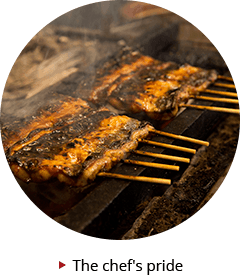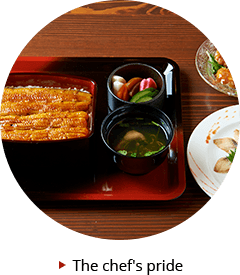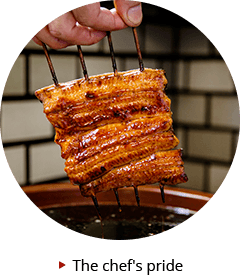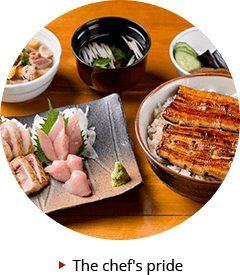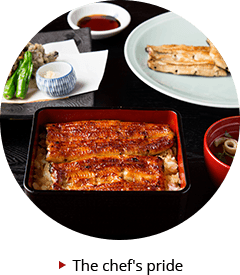Where unagi is steeped in tradition
Summer is when Japanese feast on vitamin-rich unagi (freshwater eel) to gain stamina in the hot, humid weather. Treat yourself to delicious, nutritious unagi at one of Tokyo's finest traditional unagi restaurants.
 Unagi Uomasa
As fresh as it gets
Unagi Uomasa
As fresh as it gets
 Iriya Kishimojinmonzen Nodaya
Japan's benchmark unagi
Iriya Kishimojinmonzen Nodaya
Japan's benchmark unagi
 Hashimoto
The sauce comes first
Hashimoto
The sauce comes first
 Kawaei
Tenderness is the secret
Kawaei
Tenderness is the secret
 Unagi Fujita Shirokanedai
Fourth-generation Fujita
Unagi Fujita Shirokanedai
Fourth-generation Fujita
Unagi Uomasaうなぎ魚政
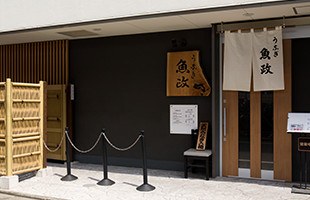
Phone: 03-3695-5222
- Address:
- 4-14-4, Higashi Yotsugi, Katsushika-ku, Tokyo
- Open:
- Mondays, Wednesdays to Sundays, holidays and the day before holidays
Lunch 11:30 – last order 13:00
Dinner 17:00 – last order 20:00
Despite business hours, the shop will close when sold out - Closed:
- Tuesdays, first and third Wednesdays of the month
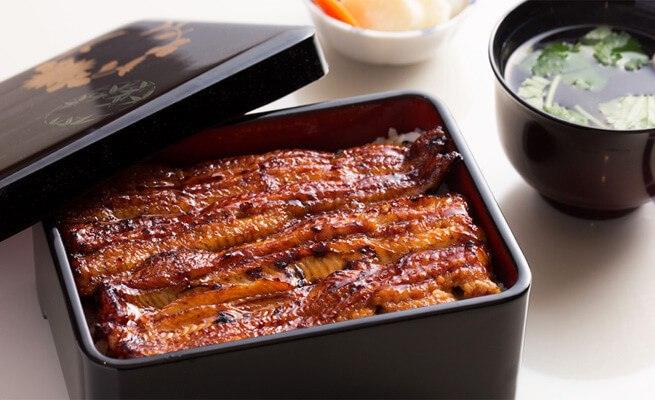
The unajyu features Bando Taro unagi with fat and tender meat, other domestically raised unagi (mainly from Kyushu) or wild unagi (spring to autumn only) from Lake Hamanako.

Kimowasa (boiled liver with wasabi) and hone senbei (bone crackers), the perfect accompaniment to sake, are served to unajyu customers while they wait.
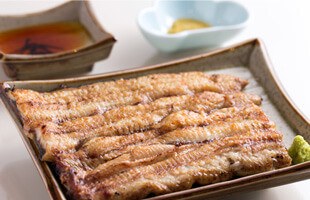
Expertly grilled shirayaki (grilled without sauce) tastes splendid whether you season it with soy sauce and wasabi or specially made kimoshio (liver salt).
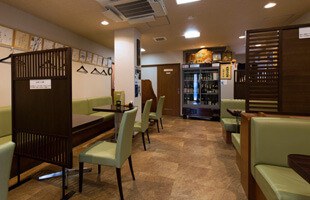
It's best to reserve in advance. Uomasa is often fully booked on weekends and holidays, as well as throughout the summer.

Unagi are kept alive until you order. Preparations include boning, skewering, shirayaki (grilled without sauce), steaming and honyaki (grilling with sauce).
As fresh as it gets
It may be a cliche to say the unagi is so tender it practically melts in your mouth. But the cliche holds true when describing the tokuchu katsuman at Unagi Uomasa. Even the crispy roasted skin dissolves like a thin layer of confectionery when it touches your tongue. Beneath the unagi lies slightly firm rice that creates a pleasing contrast with the tender meat. And the sweet tare (sauce) blends it all together wonderfully.
All unagi at Uomasa are kept alive in a tateba (purifying pool) until you place your order. You can choose from reasonably priced domestic unagi, more expensive and widely acclaimed Bando Taro brand unagi, or premium wild unagi. Once you make your selection, the unagi undergoes boning, skewering, shirayaki (grilled without sauce), steaming and honyaki (grilling with sauce) before being served.
While waiting, those who order fresh and delicious unajyu (eel on rice in a box) are served kimowasa (boiled liver with wasabi) and hone senbei (bone crackers) from the unagi being prepared. Nibbling on these tasty appetizers raises expectations and makes the 40 minutes pass more quickly. Every minute is well worth the wait.

Phone: 03-3695-5222
- Address:
- 4-14-4, Higashi Yotsugi, Katsushika-ku, Tokyo
- Open:
- Mondays, Wednesdays to Sundays, holidays and the day before holidays
Lunch 11:30 – last order 13:00
Dinner 17:00 – last order 20:00
Despite business hours, the shop will close when sold out - Closed:
- Tuesdays, first and third Wednesdays of the month
Iriya Kishimojinmonzen Nodaya入谷鬼子母神門前のだや
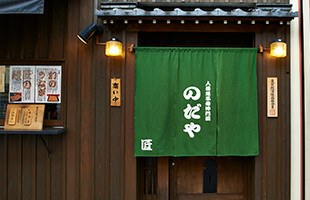
Phone: 03-3872-0517
- Address:
- 2-3-1 Shitaya, Taito-ku, Tokyo
- Open:
- Tuesdays to Sundays, holidays and days before holidays
Lunch 11:30 – last order 14:00
Dinner 17:30 – last order 20:00
Despite business hours, the shop will close when sold out - Closed:
- Mondays (if a holiday falls on Monday, the shop opens on Monday and closes on Tuesday)

Legendary kyosui unagi in unajyu (eel topped rice in a box) is artificially raised to experience all four seasons five times in two years, resulting in meat that closely resembles wild unagi.
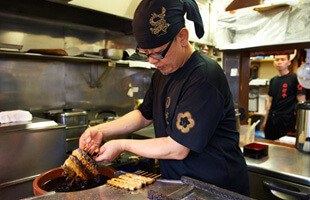
The demanding manben gaeshi (ten-thousand turnover) grilling technique requires repeated flipping without scorching the meat.
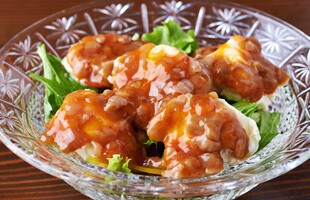
Lightly blanched unagi dressed with cream cheese and shuto (salted fish innards) is one of the master's original, highly recommended recipes.
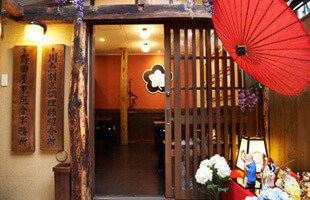
Nodaya has been in business for over 50 years but opened at its current location in 2013. The head master is a leader in Japan's unagi industry.
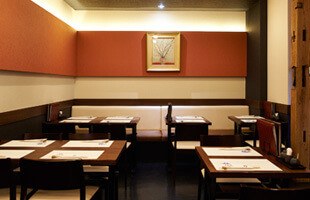
The atmosphere is casual, attracting customers of all generations. There's a lounge upstairs and tables on the first floor and annex.
Japan's benchmark unagi
In Japan, just as there are stables for training sumo wrestlers, there are establishments for training unagi (eel) chefs, who are strictly trained by unagi masters then snatched up by leading unagi restaurants throughout Japan. The most prestigious of these establishments, founded in 1868, is the Nodaya Chef Introduction Agency that operates one restaurant — Iriya Kishimojinmonzen Nodaya. Here, the head master practices his wizardry to present benchmark Japanese unagi.
The primary unagi preparation skill is manben gaeshi (ten thousand turnovers), the nonstop flipping of skewered unagi over flaming charcoal. The chef must continuously check the charcoal and meat to ensure even penetration of heat. The skin should appear charcoal roasted, while the meat stays light brown. This painstaking process produces an amazingly tender golden fillet with meat soft enough to melt in your mouth and a skin that is firm and aromatic. A light tare (sauce) enriched by unagi fat adds multiple layers of flavor.
In texture, taste and aroma, grilled unagi is the summit of all unagi dishes and few chefs can match the skill of Nodaya's master chef. However, the name of the chef grilling unagi is always posted, reflecting the pride of every chef at Nodaya.

Phone: 03-3872-0517
- Address:
- 2-3-1 Shitaya, Taito-ku, Tokyo
- Open:
- Tuesdays to Sundays, holidays and days before holidays
Lunch 11:30 – last order 14:00
Dinner 17:30 – last order 20:00
Despite business hours, the shop will close when sold out - Closed:
- Mondays (if a holiday falls on Monday, the shop opens on Monday and closes on Tuesday)
Hashimotoはし本
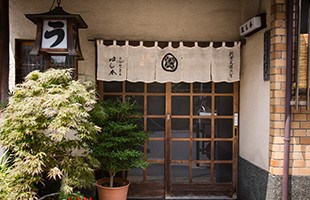
Phone: 03-3811-4850
- Address:
- 2-5-7 Suido, Bunkyo-ku, Tokyo
- Open:
- Mondays to Wednesdays, Fridays to Sundays, holidays and day before holidays
Lunch 11:30 – last order 14:00
Dinner 16:30 – last order 19:30 - Closed:
- Thursdays
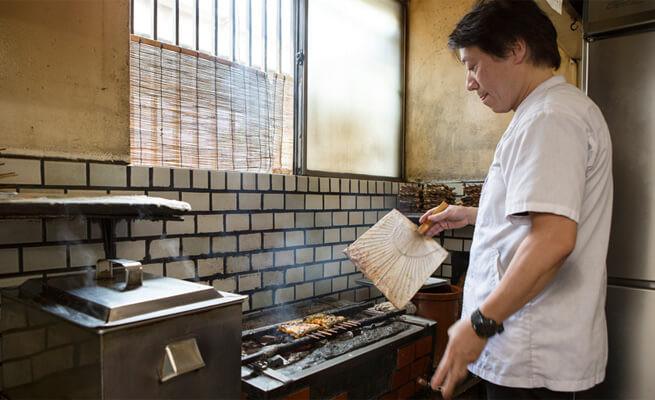
Sixth-generation owner chef Shinji Hashimoto tends the same grill he tended part time in college. After graduation, he worked both at the restaurant and an unagi wholesale firm to perfect his unagi selection and boning skills.

Hashimoto's tare is more salty than sweet. The exquisite unagi in his unajyu (eel on rice in a box) jo (top grade) is just the right texture.
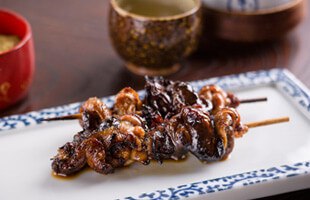
Kimoyaki (grilled liver) are slightly bitter but splendidly aromatic and pair perfectly with sake.
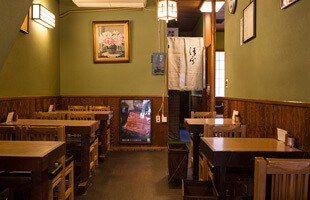
The rustic building was built in 1974. There are tables and tatami mat seats on the first floor and private rooms upstairs.
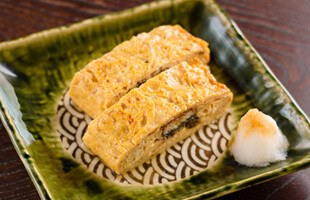
The thick, delectable umaki omelettes are filled with roasted unagi (minimum two-person order).
The sauce comes first
Hashimoto restaurant at the foot of Ishikiribashi Bridge has been serving customers for over 180 years since its establishment in 1835. What kind of unagi does the sixth-generation owner of this highly renowned unagi restaurant seek? His answer may surprise you.
"Don't get me wrong," says owner chef Shinji Hashimoto, "but I think the environment where unagi is raised is more important than the location. I want unagi that complements our tare (sauce) and drips fat as fragrant as white fish on charcoal when prepared as shirayaki (grilled without sauce)."
He seeks unagi with a fresh, traditional flavor that can be prepared to match the restaurant's tare — a refined, mildly sweet sauce passed down for many generations. With pride, he overcomes all challenges to maintain the family legacy. He considers one kilogram per two and a half unagi to be the ideal size. Few other restaurants serve unagi this large, but Hashimoto finds it best matches his tare and offers other advantages as well. "Raising young unagi to adulthood is expensive, but growing them larger is not," he says. "The cost savings for our restaurant are minimal, but it preserves natural resources." He finds this important because the unagi industry is facing a serious shortage of glass unagi for stocking these days. More important, however, to this sixth-generation owner is the flavor of his unagi and the ability to pass down the culinary heritage of his restaurant to future generations.

Phone: 03-3811-4850
- Address:
- 2-5-7 Suido, Bunkyo-ku, Tokyo
- Open:
- Mondays to Wednesdays, Fridays to Sundays, holidays and day before holidays
Lunch 11:30 – last order 14:00
Dinner 16:30 – last order 19:30 - Closed:
- Thursdays
Kawaei川栄
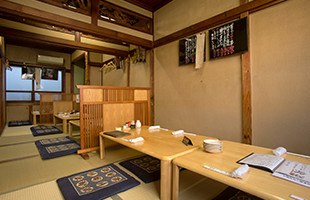
Phone: 03-3901-3729
- Address:
- 1-19-16 Akabane, Kita-ku, Tokyo
- Open:
- Sundays and holidays 11:30 – last order 17:00
Mondays, Tuesdays, Thursdays to Saturdays
Lunch 11:30 – last order 14:00
Dinner 18:00 – last order 21:30
Despite business hours, the shop will close when sold out - Closed:
- Wednesdays (if a holiday falls on Wednesday, the shop is open on Wednesday and closed on Thursday)
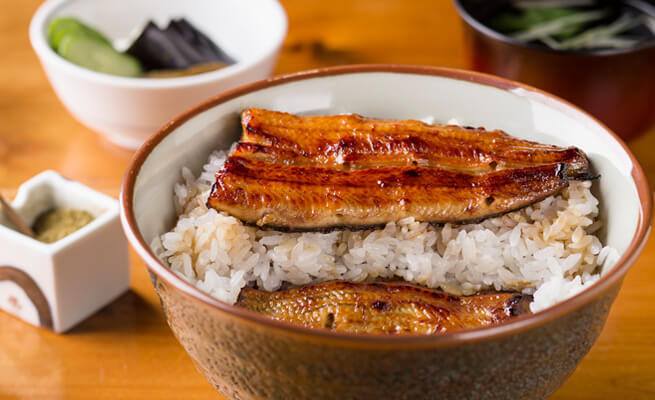
Shinobi (secretly hiding) Extra Special hides an extra layer of unagi beneath the rice. The dish, originally created to please hungry local workers, is also available in a lunch box. But the bowl makes it easier to dig with abandon.
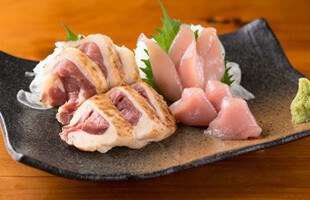
Fresh Guinea fowl sashimi from Iwate Prefecture is another signature dish at Kawaei.

Third-generation owner chef Yusuke Ishii instinctively knows exactly how long to steam and grill each unagi.
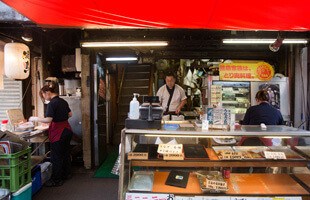
Kabayaki (grilled eel without rice) and yakitori are available for takeout. The tempting aroma is like a magnet for passersby.
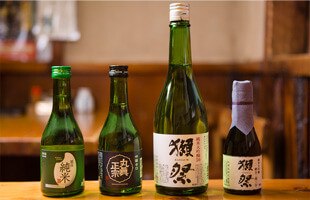
Customers can order bottles of sake of various brands from popular Dassai to local Marushin Masamune.
Tenderness is the secret
Throughout the Kanto Plain in eastern Japan, unagi are usually grilled both before and after steaming. But Kawaei forgoes the first grilling to serve unagi that is more plump and tender. The technique was perfected by the wife of Kawaei's founder who launched the shop in 1946. Having been raised in a boathouse, she was well versed in freshwater fish preparation and brought her deep expertise to Kawaei. Her unique recipe has remained a cherished tradition at the restaurant for three generations.
Many chefs have attempted to replicate the recipe to minimize unagi shrinkage and serve more tender meat. But achieving success without first grilling the unagi is a difficult feat — and Kawaei has kept its original unagi recipe a secret all these years. The restaurant's delicious tare (sauce) was originally made extra rich and thick to satisfy the many hard-working customers who visited the restaurant after their night shifts at the local factories that used to fill Akabane. The exhausted workers knew they could always depend on the ample unagi and rich, thick tare at Kawaei. This tradition of generosity carries on to the present day.
The restaurant has become so popular that guests must usually book in advance. But the service remains personal and attentive. Housewives are often seen dropping by on their bicycles to purchase takeout kabayaki (grilled eel) while guests dine in the restaurant. There's a peaceful sense that tradition carries on to everyone's satisfaction.

Phone: 03-3901-3729
- Address:
- 1-19-16 Akabane, Kita-ku, Tokyo
- Open:
- Sundays and holidays 11:30 – last order 17:00
Mondays, Tuesdays, Thursdays to Saturdays
Lunch 11:30 – last order 14:00
Dinner 18:00 – last order 21:30
Despite business hours, the shop will close when sold out - Closed:
- Wednesdays (if a holiday falls on Wednesday, the shop is open on Wednesday and closed on Thursday)
Unagi Fujita Shirokanedaiうなぎ 藤田 白金台店
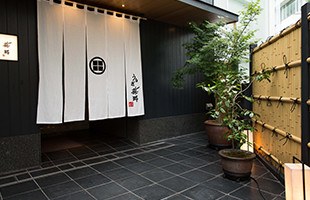
Phone: 03-6432-5636
- Address:
- 3F, IGAX Bldg., 4-19-21 Shirokanedai, Minato-ku, Tokyo
- Open:
- Tuesdays to Sundays, holidays and the day before holidays
Lunch 11:30 – last order 14:00
Dinner 17:00 - last order 21:00 - Closed:
- Mondays
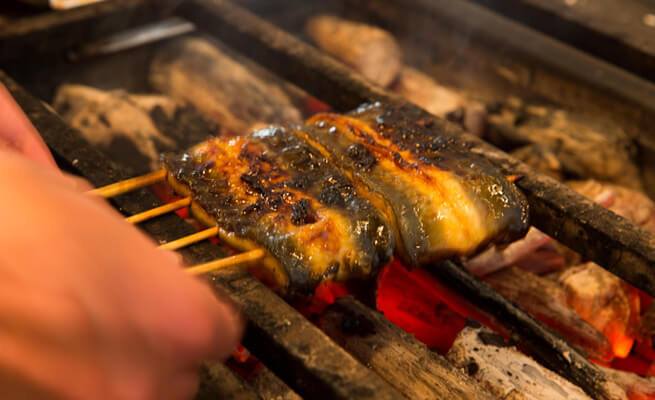
Genuine Kishu binchotan charcoal produces plump unagi with a tantalizing aroma. "Our unagi is lightly grilled and steamed before the final grilling, during which the unagi is repeatedly dipped in tare," owner chef Fujita explains.
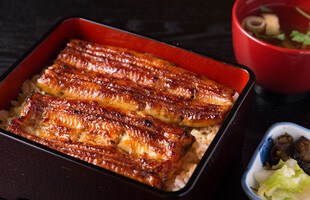
Unajyu (grilled eel on rice in a box) Yama with kimosui (clear liver soup) and pickles. The firmness of the rice complements the unagi.

Slightly bitter kimo (liver) tempura appetizer. Other kimo dishes include kimoyaki (grilled liver) and kimowasa (boiled liver with wasabi).
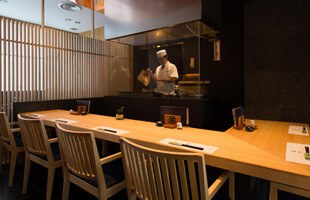
There are premium seats at the spacious counter and comfortable table seats as well.
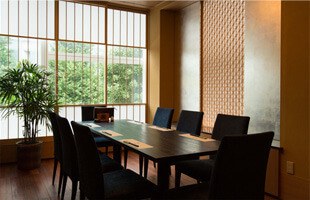
The spacious private room seats eight. Its large windows were specially designed for a pleasant dining experience.
Fourth-generation Fujita
"The unagi we serve is amply grilled and aromatic," explains Masanori Fujita, the gentle owner chef of Unagi Fujita. "It's Hamamatsu style."
The Fujita family has been in the unagi business for four generations. His great grandfather sold unagi from Hamanako Lake to kappo restaurants and ryotei restaurants in the Meiji Era, his grandfather ran an unagi farm and his father launched an unagi restaurant in 1964.
The main restaurant is prospering in Hamamatsu City and he opened this branch in Shirokanedai in March 2016 to meet the growing demand in Tokyo for Fujita unagi. Many Tokyo residents were traveling all the way to Hamamatsu just to dine at his family's restaurant, and his special unagi sales at Tokyo department stores were a great success.
Most of the unagi served at Fujita Shirokanedai and the main restaurant in Hamamatsu are from Hamanako Lake. The restaurants are steadily supplied with high-quality unagi through a distribution channel established by his family long ago. These unagi are kept alive in fresh water from a 115-meter deep well for about a week without feeding to firm the meat.
The unagi is dipped in tare (sauce) from the same recipe used by his family for generations. Light and tasty, it becomes pleasingly aromatic after the unagi is grilled. His spacious dining room brightened by sunshine from large windows also deserves praise. "I want guests to enjoy unagi in a relaxing environment," Fujita tells us. From the counter seats, visitors can observe his attentive preparation and sense his pride in preserving the family's culinary heritage. "Unagi is in my blood," he tells us, while preparing some of the best unagi in Tokyo.

Phone: 03-6432-5636
- Address:
- 3F, IGAX Bldg., 4-19-21 Shirokanedai, Minato-ku, Tokyo
- Open:
- Tuesdays to Sundays, holidays and the day before holidays
Lunch 11:30 – last order 14:00
Dinner 17:00 - last order 21:00 - Closed:
- Mondays
*Articles are written based on information available at the time of publication.
More restaurants



